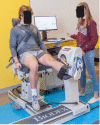Isokinetic Assessment of Knee Flexor and Extensor Strength and Lower Extremity Flexibility Assessment of an NCAA Division III Men's Soccer Team
- PMID: 37425103
- PMCID: PMC10324297
- DOI: 10.26603/001c.74971
Isokinetic Assessment of Knee Flexor and Extensor Strength and Lower Extremity Flexibility Assessment of an NCAA Division III Men's Soccer Team
Abstract
Background: Strength imbalances and flexibility deficits of the hamstrings and hip flexors have been identified as potential risk factors for hamstring injuries, but research on athletes at the Division III level are limited, potentially due to a lack of resources and technology.
Purpose: The purpose of this study was to conduct isokinetic and flexibility assessments to screen male soccer athletes at risk of sustaining a hamstring injury.
Study design: Observational cohort.
Methods: Standardized isokinetic testing of concentric muscle performance, measured by peak torque of the quadriceps and hamstrings and hamstring-to-quadriceps ratios, was conducted using a Biodex isokinetic dynamometer at speeds of 60 and 180°/sec. Additionally, the Active Knee Extension (AKE) test and the Thomas test were performed bilaterally to objectively measure flexibility. Paired sample t-tests were used to compare left and right lower extremities for all outcomes, with the level of significance set at p<0.05. Participants were ranked for risk and given a set of exercises sourced from the FIFA 11 Injury Prevention Program.
Results: At 60°/sec, the mean PT/BW bilateral deficit was 14.1% for extension and 12.9% for flexion. At 180°/sec, the mean deficit was 9.9% for extension and 11.4% for flexion. The team's average for left and right H:Q ratios for each speed were 54.4 and 51.4 at 60°/sec and 61.6 and 63.1 at 180°/sec, respectively. The team's average AKE range of motion was 158° for the left leg and 160° for the right leg. The mean Thomas test measurements were 3.6° away from the neutral position on the right and 1.6° on the left, with nine positive tests. There were no statistically significant differences between left and right knee extension or flexion PT/BW or H:Q ratios at either speed. There was no significant difference between left and right AKE measurements (p=0.182).
Conclusion: The results of this screening suggest that isokinetic testing and flexibility testing may be useful to identify non-optimal strength ratios and flexibility deficits in male collegiate soccer players. The benefits of this research have direct implications, as participants received both their screening data and a set of exercises aimed to help decrease their injury risk, in addition to the offering data that is useful for determining what normative values for flexibility and strength profiles might look like for Division III male soccer players.
Level of evidence: Level 3.
Keywords: Flexibility assessment; hamstring injury; isokinetic testing; screening.
Conflict of interest statement
The authors report no conflicts of interest.
Figures




References
-
- Diemer WM, Winters M, Tol JL, Pas HIMFL, Moen MH. Incidence of acute hamstring injuries in soccer: a systematic review of 13 studies involving more than 3800 athletes with 2 million sport exposure hours. J Orthop Sports Phys Ther. 2021;51(1):27-36. doi:10.2519/jospt.2021.9305 - PubMed
-
- Ekstrand J, Waldén M, Hägglund M. Hamstring injuries have increased by 4% annually in men’s professional football, since 2001: a 13-year longitudinal analysis of the UEFA Elite Club injury study. Br J Sports Med. 2016;50(12):731-737. doi:10.1136/bjsports-2015-095359 - PubMed
-
- Croisier JL, Ganteaume S, Binet J, Genty M, Ferret JM. Strength imbalances and prevention of hamstring injury in professional soccer players: a prospective study. Am J Sports Med. 2008;36(8):1469-1475. doi:10.1177/0363546508316764 - PubMed
LinkOut - more resources
Full Text Sources
Research Materials
